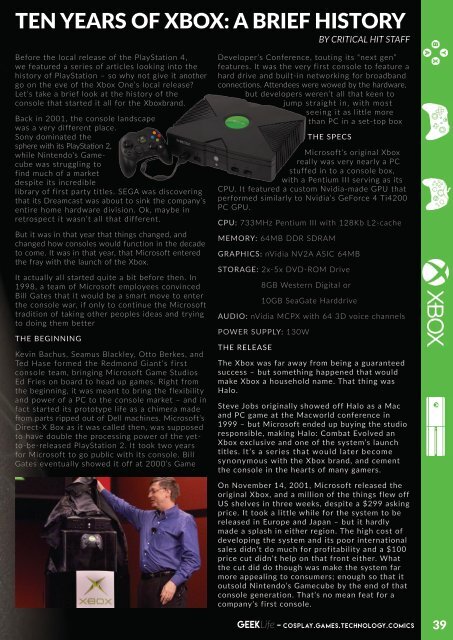Geek Life
A magazine for all geeks that love, cosplay, games, technology and comics
A magazine for all geeks that love, cosplay, games, technology and comics
Create successful ePaper yourself
Turn your PDF publications into a flip-book with our unique Google optimized e-Paper software.
TEN YEARS OF XBOX: A BRIEF HISTORY<br />
BY CRITICAL HIT STAFF<br />
Before the local release of the PlayStation 4,<br />
we featured a series of articles looking into the<br />
history of PlayStation – so why not give it another<br />
go on the eve of the Xbox One’s local release?<br />
Let’s take a brief look at the history of the<br />
console that started it all for the Xboxbrand.<br />
Back in 2001, the console landscape<br />
was a very different place.<br />
Sony dominated the<br />
sphere with its PlayStation 2,<br />
while Nintendo’s Gamecube<br />
was struggling to<br />
find much of a market<br />
despite its incredible<br />
library of first party titles. SEGA was discovering<br />
that its Dreamcast was about to sink the company’s<br />
entire home hardware division. Ok, maybe in<br />
retrospect it wasn’t all that different.<br />
But it was in that year that things changed, and<br />
changed how consoles would function in the decade<br />
to come. It was in that year, that Microsoft entered<br />
the fray with the launch of the Xbox.<br />
It actually all started quite a bit before then. In<br />
1998, a team of Microsoft employees convinced<br />
Bill Gates that it would be a smart move to enter<br />
the console war, if only to continue the Microsoft<br />
tradition of taking other peoples ideas and trying<br />
to doing them better<br />
THE BEGINNING<br />
Kevin Bachus, Seamus Blackley, Otto Berkes, and<br />
Ted Hase formed the Redmond Giant’s first<br />
console team, bringing Microsoft Game Studios<br />
Ed Fries on board to head up games. Right from<br />
the beginning, it was meant to bring the flexibility<br />
and power of a PC to the console market – and in<br />
fact started its prototype life as a chimera made<br />
from parts ripped out of Dell machines. Microsoft’s<br />
Direct-X Box as it was called then, was supposed<br />
to have double the processing power of the yetto-be-released<br />
PlayStation 2. It took two years<br />
for Microsoft to go public with its console. Bill<br />
Gates eventually showed it off at 2000’s Game<br />
Developer’s Conference, touting its “next gen”<br />
features. It was the very first console to feature a<br />
hard drive and built-in networking for broadband<br />
connections. Attendees were wowed by the hardware,<br />
but developers weren’t all that keen to<br />
jump straight in, with most<br />
seeing it as little more<br />
than PC in a set-top box<br />
THE SPECS<br />
Microsoft’s original Xbox<br />
really was very nearly a PC<br />
stuffed in to a console box,<br />
with a Pentium III serving as its<br />
CPU. It featured a custom Nvidia-made GPU that<br />
performed similarly to Nvidia’s GeForce 4 Ti4200<br />
PC GPU.<br />
CPU: 733MHz Pentium III with 128Kb L2-cache<br />
MEMORY: 64MB DDR SDRAM<br />
GRAPHICS: nVidia NV2A ASIC 64MB<br />
STORAGE: 2x-5x DVD-ROM Drive<br />
8GB Western Digital or<br />
10GB SeaGate Harddrive<br />
AUDIO: nVidia MCPX with 64 3D voice channels<br />
POWER SUPPLY: 130W<br />
THE RELEASE<br />
The Xbox was far away from being a guaranteed<br />
success – but something happened that would<br />
make Xbox a household name. That thing was<br />
Halo.<br />
Steve Jobs originally showed off Halo as a Mac<br />
and PC game at the Macworld conference in<br />
1999 – but Microsoft ended up buying the studio<br />
responsible, making Halo: Combat Evolved an<br />
Xbox exclusive and one of the system’s launch<br />
titles. It’s a series that would later become<br />
synonymous with the Xbox brand, and cement<br />
the console in the hearts of many gamers.<br />
On November 14, 2001, Microsoft released the<br />
original Xbox, and a million of the things flew off<br />
US shelves in three weeks, despite a $299 asking<br />
price. It took a little while for the system to be<br />
released in Europe and Japan – but it hardly<br />
made a splash in either region. The high cost of<br />
developing the system and its poor international<br />
sales didn’t do much for profitability and a $100<br />
price cut didn’t help on that front either. What<br />
the cut did do though was make the system far<br />
more appealing to consumers; enough so that it<br />
outsold Nintendo’s Gamecube by the end of that<br />
console generation. That’s no mean feat for a<br />
company’s first console.<br />
GEEK<strong>Life</strong> GEEK<strong>Life</strong> - Cosplay.Games.TEchnology.Comics<br />
- Comics<br />
39


